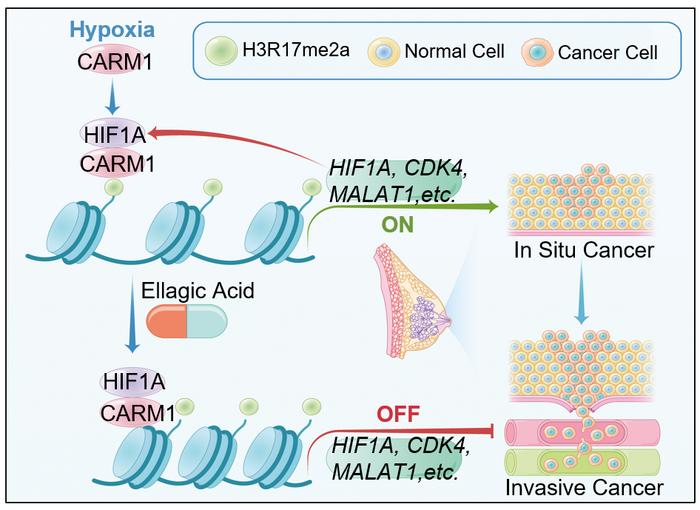The article includes an introduction to the significance of breast cancer, particularly TNBC, and the role of post-translational modifications such as arginine methylation. The study details the expression and functional analysis of CARM1 in breast cancer, its interaction with HIF1A, and its impact on TNBC progression. Experimental data demonstrate that CARM1 promotes proliferation, invasion, EMT, and stemness in TNBC cells. Genome-wide analysis identifies CARM1’s transcriptional targets, emphasizing its role in various signaling pathways. The study concludes with findings on the potential therapeutic effects of ellagic acid as a CARM1 inhibitor.

Credit: Dandan Feng, Jie Gao, Ruiqiong Liu, Wei Liu, Tianyang Gao, Yunkai Yang, Die Zhang, Tianshu Yang, Xin Yin, Hefen Yu, Wei Huang, and Yan Wang
The article includes an introduction to the significance of breast cancer, particularly TNBC, and the role of post-translational modifications such as arginine methylation. The study details the expression and functional analysis of CARM1 in breast cancer, its interaction with HIF1A, and its impact on TNBC progression. Experimental data demonstrate that CARM1 promotes proliferation, invasion, EMT, and stemness in TNBC cells. Genome-wide analysis identifies CARM1’s transcriptional targets, emphasizing its role in various signaling pathways. The study concludes with findings on the potential therapeutic effects of ellagic acid as a CARM1 inhibitor.
Key findings from the study include:
- CARM1 is highly expressed in breast cancer tissues, particularly in basal-like and triple-negative breast cancers. Clinical data and experimental analyses confirm its upregulation and correlation with breast cancer progression.
- Gain- and loss-of-function experiments show that CARM1 overexpression increases proliferation and invasion in TNBC cells, while its knockdown inhibits these processes. CARM1 influences cell cycle regulation and EMT marker expression.
- CARM1 overexpression leads to increased expression of mesenchymal markers and stemness-related genes, promoting EMT and stem cell-like properties in TNBC cells. Knockdown of CARM1 results in the opposite effect.
- Chromatin immunoprecipitation sequencing (ChIP-seq) and RNA sequencing (RNA-seq) identify CARM1’s binding sites and target genes. CARM1 regulates genes involved in key signaling pathways such as HIF-1, Wnt, and VEGF, contributing to TNBC progression.
- CARM1 physically associates with HIF1A, and this interaction is crucial for its recruitment to target gene promoters. This partnership drives the expression of genes critical for cell cycle progression and survival under hypoxic conditions.
- Ellagic acid, a natural inhibitor of CARM1, effectively reduces TNBC cell proliferation and invasion by directly inhibiting CDK4 expression. This finding suggests that targeting CARM1 with ellagic acid could be a promising therapeutic strategy for TNBC.
The study concludes that CARM1 plays a significant role in the progression of triple-negative breast cancer by interacting with HIF1A and regulating genes involved in cell cycle and signaling pathways. The upregulation of CARM1 in breast cancer tissues, especially in more aggressive subtypes like TNBC, highlights its potential as a biomarker for cancer progression. Experimental evidence demonstrates that CARM1 enhances proliferation, invasion, EMT, and stemness in TNBC cells, indicating its pivotal role in cancer metastasis and resistance to treatment. The identification of ellagic acid as a potent inhibitor of CARM1 opens new avenues for therapeutic intervention. By suppressing CDK4 expression, ellagic acid shows promise in reducing TNBC proliferation and invasion, providing a potential natural compound for cancer therapy. This research underscores the importance of targeting CARM1 in developing effective treatments for TNBC and possibly other cancers with elevated CARM1 expression. The work entitled “ CARM1 drives triple-negative breast cancer progression by coordinating with HIF1A ” was published on Protein & Cell (published on Mar. 13, 2024).
Journal
Protein & Cell
Method of Research
Experimental study
Subject of Research
Animals
Article Title
CARM1 drives triple-negative breast cancer progression by coordinating with HIF1A
Article Publication Date
13-Mar-2024



